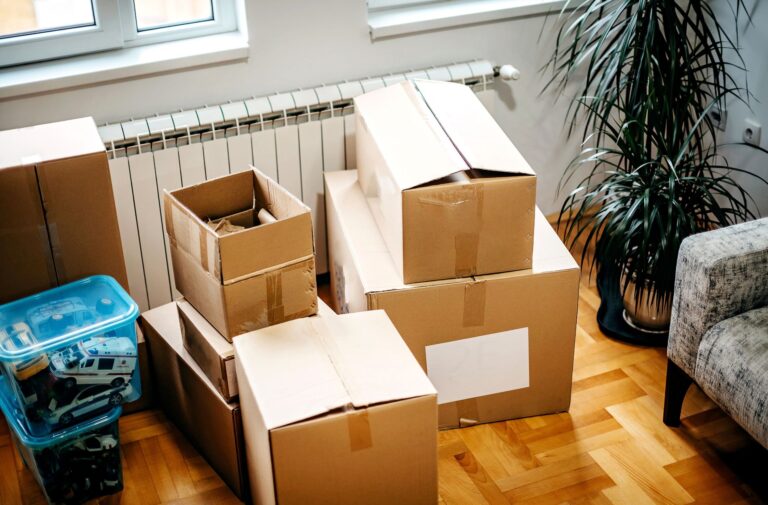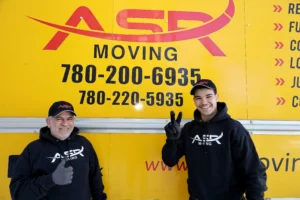Moving in the winter brings unique challenges, especially in Edmonton, where freezing temperatures, snow-covered roads, and icy conditions can make the process more difficult. Slippery sidewalks, unpredictable weather, and shorter daylight hours add to an already demanding task.
However, with careful planning and the right approach, you can make your winter move smooth and stress-free.
From choosing the best moving day to protecting your belongings from the cold, a little preparation goes a long way. Whether relocating across town or settling into Edmonton for the first time, these essential tips will help you move safely and efficiently.
1. Plan Your Move Around the Weather
Edmonton winters can be unpredictable, with sudden snowstorms and extreme cold making travel difficult. That’s why it’s crucial to check the weather forecast regularly before your move.
- Monitor Weather Conditions Early: Check the long-term and short-term forecast leading up to your move. Use reliable sources like The Weather Network or Environment Canada to track potential snowstorms or deep freezes.
- Set Up Weather Alerts: Consider signing up for weather alerts on your phone to receive real-time updates on sudden temperature drops, snow warnings, or dangerous wind chills.
- Check Road Conditions in Advance: Alberta’s 511 Road Reports provide up-to-date information on icy roads, traffic delays, and highway closures. This is especially helpful if you’re driving a long distance.
- Have a Backup Plan: If a severe storm is expected, it may be safer to delay your move by a day or two. Discuss backup options with your moving company to avoid last-minute stress.
- Move Early in the Day: Winter days are shorter, and moving in the dark can be dangerous. Aim to start early so you have plenty of daylight for loading and unloading.
2. Hire Experienced Local Movers
Winter moving requires extra caution, and professional movers with experience handling Edmonton’s winter conditions can make the process much easier.
- Choose a Winter-Ready Moving Company: Not all moving companies in Edmonton are equipped to handle snowy conditions. Look for movers who have experience navigating icy roads, using proper safety gear, and protecting belongings from freezing temperatures.
- Ask About Equipment & Vehicles: Reliable movers should have trucks equipped with winter tires, all-weather moving blankets, and protective coverings for furniture.
- Confirm Their Winter Safety Practices: A good moving company will take extra precautions, such as salting pathways before loading, wrapping furniture in weather-resistant covers, and ensuring movers wear slip-resistant footwear.
Hiring professionals can save time, reduce stress, and minimize injury risks during a winter move.
3. Keep Walkways Clear and Safe
Winter conditions can turn a simple move into a hazardous one, increasing the risk of slips, falls, and damage to your belongings. Ensuring safe access to your home is crucial for both you and your movers. Taking the time to clear and prepare walkways before moving day will make the process much safer and more efficient.
Shovel and De-Ice Walkways in Advance
- Start Early: Snow and ice can build up quickly, especially overnight. Shovel your driveway, sidewalks, and entryways the evening before and again on moving day if needed.
- Use the Right Tools: A sturdy snow shovel with an ergonomic handle can help you remove snow without straining your back. A snowblower is also a great option for clearing large areas.
- Break Up Ice Patches: Thick ice can be tricky to remove, so use an ice chopper or a sturdy shovel to break it up before applying salt.
Prevent Slips with Salt or Sand
- Apply Ice Melt or Rock Salt: Spreading ice melt on walkways helps prevent ice from forming and provides better traction for movers carrying heavy boxes. Look for pet-safe options if you have animals.
- Use Sand or Kitty Litter for Extra Grip: If temperatures are too cold for salt to work effectively, sprinkle sand or non-clumping kitty litter on walkways to improve traction.
Create a Clear, Safe Path for Movers
- Clear a Path to the Moving Truck: Ensure there’s a wide, snow-free walkway leading from your home to the moving truck so movers don’t have to step on icy patches.
- Mark Hidden Hazards: Snow can obscure curbs, steps, or uneven pavement. Use bright-colored flags, cones, or markers to alert movers to potential trip hazards.
- Keep a Snow Shovel and Ice Melt Handy: Edmonton’s weather can change quickly. Have a shovel and ice melt nearby for last-minute touch-ups if snow starts falling again.
A little extra effort in preparing your walkways can make a big difference in ensuring a smooth, injury-free moving day. Safe footing means fewer delays and a faster, stress-free move!
4. Protect Your Belongings from Cold Temperatures
Edmonton’s freezing temperatures can be tough on your belongings, especially delicate or temperature-sensitive items. Cold weather can cause electronics to malfunction, glass to become brittle, and wooden furniture to expand or crack. Taking the right precautions will help prevent damage and ensure your possessions arrive at your new home in perfect condition.
Wrap Fragile Items with Extra Insulation
- Use Thick Padding: Protect breakable items like dishes, mirrors, and picture frames with extra layers of bubble wrap, blankets, or foam padding to shield them from extreme cold.
- Double-Wrap Electronics: Laptops, TVs, and gaming consoles are especially vulnerable to temperature changes. Wrap them in blankets or thick towels and place them in well-padded boxes to keep the cold air out.
- Protect Wood and Leather Furniture: Cold, dry air can cause wood to shrink or crack and leather to stiffen. Cover wooden furniture with moving blankets and plastic wrap to create a barrier against moisture.
Use Insulated Moving Boxes for Sensitive Items
- Thermal Covers for Extra Protection: If moving items like artwork, musical instruments, or temperature-sensitive equipment, use insulated moving blankets or thermal covers to help maintain a stable temperature.
- Plastic Tubs Over Cardboard Boxes: Standard cardboard boxes can absorb moisture, making them more susceptible to damage. Consider using plastic bins for extra protection, especially for valuable or sentimental items.
Keep High-Value Electronics Warm
- Transport Electronics in a Heated Vehicle: Instead of loading expensive gadgets onto a cold moving truck, keep them in a warm car until it’s time to unload. This prevents condensation from forming when transitioning between extreme temperatures.
- Allow Time for Electronics to Adjust: Once you arrive at your new home, don’t plug in TVs, computers, or other electronics right away. Let them sit at room temperature for a few hours to avoid internal damage caused by sudden temperature shifts.
By taking these precautions, you can protect your valuable belongings from the harsh winter cold and ensure they remain in great condition during your move.
5. Dress for the Weather
Staying warm and comfortable is essential for a smooth moving day, especially in Edmonton’s freezing winter temperatures. The key is to dress in layers so you can adjust to changing conditions throughout the day.
- Wear moisture-wicking base layers to keep sweat away from your skin and prevent chills.
- Add insulating layers like fleece or wool to retain body heat.
- Top it off with a waterproof and wind-resistant jacket to protect against snow and cold winds.
- Choose warm, waterproof boots with good traction to prevent slipping on icy surfaces.
- Wear thermal gloves with a good grip so you can handle boxes without exposing your hands to the cold.
- Don’t forget a hat and scarf—a significant amount of body heat is lost through the head and neck.
Dressing appropriately will keep you warm, comfortable, and safe while tackling your winter move.
6. Keep Essentials Handy
Winter moving day conditions can be unpredictable, so having an emergency essentials bag ensures you’re prepared for any delays or unexpected challenges. Keep this bag easily accessible throughout the move, whether in your personal vehicle or a designated spot in the moving truck.
- Pack extra warm clothing, gloves, and hats in case you need to layer up. If temperatures drop suddenly or you get wet from snow, having dry, warm clothing will keep you comfortable.
- Bring hot drinks and snacks to stay energized and warm during the move. A thermos filled with coffee, tea, or hot chocolate can be a lifesaver in freezing weather.
- Include a first-aid kit with bandages, pain relievers, and any necessary medications. Slippery conditions increase the risk of minor injuries, so it’s best to be prepared.
- Keep important documents and keys handy to avoid unnecessary stress. Make sure you have your lease or home purchase agreement, IDs, moving contracts, and any other essential paperwork in a waterproof folder.
Having these essentials within reach will help you stay warm, hydrated, and ready to handle any last-minute issues that arise during your winter move.
7. Protect Your Floors from Snow and Slush
During a winter move, constant foot traffic can track in snow, slush, and dirt, creating slippery conditions and potential damage to your floors. Wet surfaces can also be a safety hazard, increasing the risk of slips and falls. To minimize mess and protect your flooring, lay down old towels, cardboard, or plastic sheets in high-traffic areas, especially near entryways.
A heavy-duty doormat at the entrance will help catch excess moisture before it spreads throughout your home. If possible, set up a designated area where movers and helpers can remove wet footwear before stepping inside. Keeping a mop, paper towels, or a dry cloth handy will allow you to quickly clean up any puddles, helping to maintain a safe and tidy space throughout the move.
8. Prepare Your Vehicle for the Move
If you’re using your vehicle to transport belongings, make sure it’s winter-ready to avoid unexpected breakdowns or delays.
Check the battery, tires, and heating system a few days before the move to ensure everything is in working order. Winter tires or all-season tires with good tread are essential for safe driving on icy roads. Keep an emergency kit in your car, including a flashlight, extra blankets, a snowbrush, an ice scraper, jumper cables, and a small shovel in case you need to clear snow.
If you’re hiring a moving company, confirm that their trucks are winter-equipped, with proper tires and heating to protect your items from extreme cold.
9. Plan for Delays
Winter weather can be unpredictable, leading to road closures, slow traffic, and unexpected delays. Snow and ice may require movers to work more cautiously, and clearing pathways may add extra time to the process. To avoid stress, build flexibility into your schedule by allowing for extra travel time between locations.
Stay in communication with your moving team to adjust plans if necessary, and check real-time road conditions through Alberta’s 511 Road Reports before setting out. Being patient and prepared will help ensure a smoother moving experience despite the winter challenges.
10. Settle into Your New Home Comfortably
Before moving, ensure that utilities like heat, electricity, and internet are set up at your new home. Nothing is worse than arriving at a freezing house with no way to warm up!
Once inside, focus on unpacking essentials first—bedding, kitchen supplies, and warm clothing. Having hot drinks ready can also make the transition more comfortable.
Conclusion
Moving in Edmonton’s winter doesn’t have to be stressful. With proper preparation, wise precautions, and a reliable plan, you can easily navigate the challenges of cold weather and icy conditions. An organized move keeps your belongings safe, ensures a smooth moving day, and helps you stay protected from winter’s challenges.
If you need professional assistance, Asr Moving is here to help. Our experienced team understands the unique challenges of winter moves and is committed to making the process seamless. Contact us today for a free quote, and let’s make your winter move successful!
FAQ
Are winters harsh in Edmonton?
Yes, Edmonton winters are known for their extreme cold, heavy snowfall, and icy conditions. Temperatures can drop well below freezing, often reaching -30°C (-22°F) or lower with wind chills. However, with the right preparation, you can navigate the winter months safely and efficiently.
What is the coldest month in Edmonton?
January is typically the coldest month in Edmonton, with average temperatures ranging from -7°C (19°F) to -15°C (5°F). Cold snaps can bring even more extreme temperatures, sometimes dipping below -30°C (-22°F).
What month has the most snow in Edmonton?
November and December generally see the heaviest snowfall, but Edmonton can experience snow from October through April. The snowiest month varies from year to year, but February and March can also bring significant accumulations.
How long does winter last in Edmonton?
Winter in Edmonton usually lasts from late October to early April. However, cold temperatures and occasional snowfall can persist into May. The city’s long winters require extra preparation, especially for activities like moving.
Do they salt the roads in Edmonton?
Yes, Edmonton uses a combination of sand, salt, and calcium chloride to manage icy roads. Major roads, bridges, and high-traffic areas are treated regularly, but residential streets may not receive the same level of maintenance. Always check road conditions before traveling in winter.



